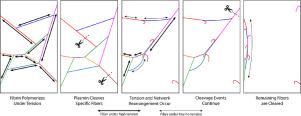当前位置:
X-MOL 学术
›
Acta Biomater.
›
论文详情
Our official English website, www.x-mol.net, welcomes your feedback! (Note: you will need to create a separate account there.)
Inherent fibrin fiber tension propels mechanisms of network clearance during fibrinolysis.
Acta Biomaterialia ( IF 9.7 ) Pub Date : 2020-02-25 , DOI: 10.1016/j.actbio.2020.02.025 Sean J Cone 1 , Andrew T Fuquay 2 , Justin M Litofsky 1 , Taylor C Dement 1 , Christopher A Carolan 3 , Nathan E Hudson 1
Acta Biomaterialia ( IF 9.7 ) Pub Date : 2020-02-25 , DOI: 10.1016/j.actbio.2020.02.025 Sean J Cone 1 , Andrew T Fuquay 2 , Justin M Litofsky 1 , Taylor C Dement 1 , Christopher A Carolan 3 , Nathan E Hudson 1
Affiliation

|
Proper wound healing necessitates both coagulation (the formation of a blood clot) and fibrinolysis (the dissolution of a blood clot). A thrombus resistant to clot dissolution can obstruct blood flow, leading to vascular pathologies. This study seeks to understand the mechanisms by which individual fibrin fibers, the main structural component of blood clots, are cleared from a local volume during fibrinolysis. We observed 2-D fibrin networks during lysis by plasmin, recording the clearance of each individual fiber. We found that, in addition to transverse cleavage of fibers, there were multiple other pathways by which clot dissolution occurred, including fiber bundling, buckling, and collapsing. These processes are all influenced by the concentration of plasmin utilized in lysis. The network fiber density influenced the kinetics and distribution of these pathways. Individual cleavage events often resulted in large morphological changes in network structure, suggesting that the inherent tension in fibers played a role in fiber clearance. Using images before and after a cleavage event to measure fiber lengths, we estimated that fibers are strained ~23% beyond their equilibrium length during polymerization. To understand the role of fiber tension in fibrinolysis we modeled network clearance under differing amounts of fiber polymerized strain (prestrain). The comparison of experimental and model data indicated that fibrin tension enables 35% more network clearance due to network rearrangements after individual cleavage events than would occur if fibers polymerized in a non-tensed state. Our results highlight many characteristics and mechanisms of fibrin breakdown, which have implications on future fibrin studies, our understanding of the fibrinolytic process, and the development of thrombolytic therapies. STATEMENT OF SIGNIFICANCE: Fibrin fibers serve as the main structural element of blood clots. They polymerize under tension and have remarkable extensibility and elasticity. After the cessation of wound healing, fibrin must be cleared from the vasculature by the enzyme plasmin in order to resume normal blood flow: a process called fibrinolysis. In this study we investigate the mechanisms that regulate the clearance of individual fibrin fibers during fibrinolysis. We show that the inherent tension in fibers enhances the action of plasmin because every fiber cleavage event results in a redistribution of the network tension. This network re-equilibration causes fibers to buckle, bundle, and even collapse, leading to a more rapid fiber clearance than plasmin alone could provide.
中文翻译:

固有的纤维蛋白纤维张力推动纤维蛋白溶解过程中的网络清除机制。
适当的伤口愈合需要凝血(血凝块的形成)和纤维蛋白溶解(血凝块的溶解)。抗凝块溶解的血栓会阻碍血流,导致血管病变。本研究旨在了解单个纤维蛋白纤维(血栓的主要结构成分)在纤维蛋白溶解过程中从局部体积中清除的机制。我们观察了纤溶酶裂解过程中的二维纤维蛋白网络,记录了每根纤维的间隙。我们发现,除了纤维的横向裂解之外,还有多种其他途径发生凝块溶解,包括纤维束、屈曲和塌陷。这些过程都受到裂解中使用的纤溶酶浓度的影响。网络纤维密度影响这些路径的动力学和分布。个体裂解事件通常会导致网络结构发生较大的形态变化,这表明纤维的固有张力在纤维间隙中发挥了作用。使用裂解事件前后的图像来测量纤维长度,我们估计纤维在聚合过程中的应变超出其平衡长度约 23%。为了了解纤维张力在纤维蛋白溶解中的作用,我们对不同量的纤维聚合应变(预应变)下的网络间隙进行了建模。实验数据和模型数据的比较表明,与纤维在非张力状态下聚合时相比,由于单个裂解事件后网络重排,纤维蛋白张力可使网络清除率增加 35%。我们的结果突出了纤维蛋白分解的许多特征和机制,这对未来的纤维蛋白研究、我们对纤维蛋白溶解过程的理解以及溶栓疗法的发展具有影响。意义声明:纤维蛋白纤维是血栓的主要结构元素。它们在张力下聚合,具有显着的延展性和弹性。伤口愈合停止后,必须通过纤溶酶从脉管系统中清除纤维蛋白,以恢复正常的血流:这一过程称为纤维蛋白溶解。在这项研究中,我们研究了纤溶过程中调节单个纤维蛋白纤维清除的机制。我们表明,纤维的固有张力增强了纤溶酶的作用,因为每次纤维裂解事件都会导致网络张力的重新分布。这种网络重新平衡导致纤维弯曲、成束,甚至塌陷,从而导致比单独使用纤溶酶更快的纤维清除速度。
更新日期:2020-02-25
中文翻译:

固有的纤维蛋白纤维张力推动纤维蛋白溶解过程中的网络清除机制。
适当的伤口愈合需要凝血(血凝块的形成)和纤维蛋白溶解(血凝块的溶解)。抗凝块溶解的血栓会阻碍血流,导致血管病变。本研究旨在了解单个纤维蛋白纤维(血栓的主要结构成分)在纤维蛋白溶解过程中从局部体积中清除的机制。我们观察了纤溶酶裂解过程中的二维纤维蛋白网络,记录了每根纤维的间隙。我们发现,除了纤维的横向裂解之外,还有多种其他途径发生凝块溶解,包括纤维束、屈曲和塌陷。这些过程都受到裂解中使用的纤溶酶浓度的影响。网络纤维密度影响这些路径的动力学和分布。个体裂解事件通常会导致网络结构发生较大的形态变化,这表明纤维的固有张力在纤维间隙中发挥了作用。使用裂解事件前后的图像来测量纤维长度,我们估计纤维在聚合过程中的应变超出其平衡长度约 23%。为了了解纤维张力在纤维蛋白溶解中的作用,我们对不同量的纤维聚合应变(预应变)下的网络间隙进行了建模。实验数据和模型数据的比较表明,与纤维在非张力状态下聚合时相比,由于单个裂解事件后网络重排,纤维蛋白张力可使网络清除率增加 35%。我们的结果突出了纤维蛋白分解的许多特征和机制,这对未来的纤维蛋白研究、我们对纤维蛋白溶解过程的理解以及溶栓疗法的发展具有影响。意义声明:纤维蛋白纤维是血栓的主要结构元素。它们在张力下聚合,具有显着的延展性和弹性。伤口愈合停止后,必须通过纤溶酶从脉管系统中清除纤维蛋白,以恢复正常的血流:这一过程称为纤维蛋白溶解。在这项研究中,我们研究了纤溶过程中调节单个纤维蛋白纤维清除的机制。我们表明,纤维的固有张力增强了纤溶酶的作用,因为每次纤维裂解事件都会导致网络张力的重新分布。这种网络重新平衡导致纤维弯曲、成束,甚至塌陷,从而导致比单独使用纤溶酶更快的纤维清除速度。



























 京公网安备 11010802027423号
京公网安备 11010802027423号